If you are planning to equip your Vacation home autonomous water supply and acquire a well, you need to familiarize yourself with drilling technology. This will save a lot of time when searching for drillers and funds during the drilling process.
Types of drilling technologies
When installing a water supply system in a private home, as a rule, one of three drilling technologies is used:
- Rotary;
- Auger;
- Shock-rope.
The difference between these technologies lies in the methods of destroying the rock inside the well, as well as in the methods of extracting soil to the surface. Naturally, depending on the technology, the set of necessary equipment also depends.
Why does the customer need to know these technologies? This will give an understanding of how the well will be drilled, what equipment will be used for this and how long it will take. In addition, the price of the work, as well as the quality of the final result, depends on the type of technology.

In the photo - drilling a well using an auger method
Screw method
The cheapest and simple option is auger drilling. That's why most of small-sized drilling rigs are based precisely on this technology. It is based on a conventional Archimedes screw (auger), with the help of which soil is extracted to the surface.
To make it easier to imagine this method, you should remember how fishermen drill a hole in the ice. Using this method, you can drill wells no more than 10 meters deep.
A special feature of this method is the ability to make holes only in relatively dry and soft soils. If at depth they find themselves hard rocks or quicksand, then it is impossible to carry out further work using the auger method.

It must be said that the technology of drilling wells under water with an auger is usually used by private “drillers” who have small installations. As a rule, finding organizations that provide such services is not difficult.
Note!
To make a well, it is not enough to simply drill a hole in the ground.
It is also necessary to properly protect the aquifer from high water, as required by the instructions.
Therefore, despite the fact that the process itself is not complicated, the qualifications of the performers are very important.

Rotary method
The technology of drilling a well under water using the rotary method is by far the most common. To make a hole in the ground using this method, a drill pipe is used, inside of which there is a rotating shaft with a bit at the end.
The load is transferred to the tip by a hydraulic installation. This method is attractive because it allows drilling to almost any depth, regardless of the type of rock.
The soil is washed out by constantly flushing the well with drilling fluid.
The solution can be supplied in two ways:
- With a pump inside the drill pipe, in this case the soil with the solution flows by gravity into the annulus.
- Gravity flow into the annulus, while the solution and rock are forcibly pumped out of the drill pipe.

It must be said that the second method, which is called backwashing, is a better way to open the aquifer, due to which the well will have a higher flow rate. However, this method is more labor-intensive and requires more complex equipment, and therefore costs significantly more.
Therefore, the choice of technology depends, in this case, on your budget and required quantity water. As a rule, if it is necessary to provide water to one household, then drilling with direct flushing is quite sufficient.
Now let's consider this technology step by step:
- First of all, the chisel is driven into the ground large diameter.
- The bit then rotates under the influence of a rotor, which is driven by a motor.
- Weighted pipes are installed between the drill pipes and the bit, which add additional load.
- During operation, soil is removed by liquid pressure from the mud pump.
- Having completed drilling the first section of soil, a casing pipe is inserted into the shaft so that the upper layers of soil do not spill into the well.
- For stability, the space between the soil and the first casing is filled with solution.
- Drilling then continues with a smaller bit, after which a narrower casing pipe is inserted.

Related articles:
Shock-rope method
This technology for drilling a water well is the oldest, slowest and most labor-intensive. However, the quality of such work is the highest. Its essence lies in the fact that the rock is destroyed by crushing it with a powerful heavy projectile, which first rises to a certain height, and then drops sharply.
As a result, the projectile destroys the soil with its weight, which is multiplied by the free fall coefficient. The destroyed rock is removed from the trunk using a bailer. If the ground is soft, then, as a rule, the bailer and chisel are combined into one projectile.
The main advantage of such drilling is that it does not require the use of drilling fluid or water. Thanks to this, it is possible to open the aquifer more accurately and thereby ensure maximum long term well service and the maximum possible flow rate. As a rule, wells made in this way last more than 50 years.
The main disadvantage of this technology for the customer is the high cost of services. In addition to the fact that this method is labor-intensive in itself, during the work it becomes necessary to isolate all the upper aquifers. In other words, as many aquifers and quicksand are in the well, so many casing pipes need to be used, which means additional costs for material and the work of specialists.

Which technology to choose?
In reality, the customer does not have much choice, especially if site conditions do not allow the use of an auger. The percussion-contact method has been almost completely replaced from the market by rotary drilling, which most likely will have to be used.
However, it is necessary to take an interest in the technology at least in order to determine the adequacy of the cost of services. If the soil conditions are suitable and the aquifer is not deep, then it is much more profitable to use the auger method.

Is it possible to drill a well yourself?
It is quite possible to drill a well with your own hands, the only question is how much time and effort it will take from you, and also how well it will be possible to isolate the trunk from the upper aquifers.
Often, developers underestimate the complexity of the work, which results in either “puddle water” being extracted from great depths, or the work is completed by specialists. At the same time, drillers have to pay almost the full cost, as if they were doing the work “from scratch.”
Therefore, before deciding to independent execution work, you need:
- Study drilling technology in detail;
- Understand what equipment you will need and Consumables;
- Make sure that your site can be drilled with a small-sized drilling rig.
Small-sized installations come in two types:
- Screw type - as a rule, these installations are homemade.
- Shock-rope type - installations can have Electrical engine or an internal combustion power unit. This is important if there is no electricity on the site.
Advice!
The installation for drilling using the percussion-rope method is considered less demanding on the soil and simpler.
With its help you can drill a well in almost any soil.
Conclusion
All existing well drilling technologies are radically different from each other, however, if the work is carried out by professionals, then each of them allows you to achieve the desired result. At the same time, preference should be given to one or another technology in accordance with one’s own financial capabilities, soil conditions and the depth of the aquifer.
For more information on this topic, watch the video in this article.
A well for water extraction is a rather complex structure. Many people today are interested in drilling water wells: process technology, tools and equipment for performing the work. The quality of water from a well or well depends on its design. The service life depends on the quality of the work performed.
How to drill a water well
Before drilling a water well, you need to choose a location for it. This must be a piece of land with approximate dimensions 4x12 m. If the house has not yet been built, then it is better to choose a place in the future basement. If the house has already been erected, then it is better to drill closer to the foundation. It is necessary to provide passage for the drilling rig and the water carrier to the work site. At a distance of approximately 2 m from the location of the drill there should not be any electrical wires. Similar measures are required general rules drilling water wells.
There are several drilling methods. But with any of them the following operations must be performed:
- rock crushing;
- excavation of crushed earth outwards;
- strengthening the walls of the well.

How is rock crushed? This is done using special rock-cutting devices. It can be explosive energy, electrical or thermal. But all these types are used quite rarely. Much more often they use others: augers, glasses, hand drills.
Remove the soil in the following ways:
- hydraulic;
- mechanical;
- pneumatic;
- combined.
The hydraulic method is carried out with water, clay solution or other technical liquid. Mechanical - using special drills, augers, bailers. With the pneumatic method, crushed rock is removed with a strong jet of compressed air. In a combined method, several of these methods are used.

The technology recommends fastening the walls of a well to water using metal casing pipes. Most often these are seamless pipes with a threaded or welded connection. Other options are also used occasionally. But it is not recommended to use stainless steel(very expensive!) and galvanized metal.
When drilling a water well, flushing is often used. This is a method in which water is supplied to the well using pumps. It then rises together with the crushed rock and settles in a special settling tank. Based on the settled rock, drillers determine the section of the site. The water then makes another circle. The rising clay solution strengthens the walls and prevents them from collapsing.
The process of drilling a well involves sequentially casing it with pipes. Drilling of wells for water is completed by pumping them, which is carried out until a completely transparent liquid flows.

Water drilling methods
The technology of drilling a well under water allows you to work in several ways:
- screw;
- rotary;
- shock-rope;
- manual
Let's look at each of them in more detail.
Auger drilling of wells is the most common and affordable way. An auger in the form of a screw enters the soil and loosens it. You can only drill in dry and soft soil. Augers are completely unsuitable for quicksand. This tool breaks down the rock and lifts it into the wellhead. Augers come in diameters from 60 to 800 mm. They can drill to a depth of 60 m, sometimes up to 100 m. Auger drilling of wells is impossible on rocky soils.

The rotary method is continuous action a tool called a rotor. It is constantly rotating. The rock is washed away by the clay solution. This method is relatively cheap and quite fast. But in cold weather it requires insulation of the system through which water circulates. Drilling is carried out using machines:
- URB-2A2;
- MBU-2M;
- URB-2.5;
- URB-3AM.
URB-2A2 is capable of drilling soil to a depth of 55 m, URB-2.5 - up to 300 m, and URB-3AM - up to 500 m.
The shock-rope method is the most labor-intensive. But you shouldn’t forget it, as it is of the highest quality. The rock is destroyed after being hit by a heavy object. This is a specially shaped pointed glass made of steel pipe. It falls from a height, hits the ground, picks up the destroyed soil and rises. At the top the glass is cleaned and thrown down again.

The drilling rig itself can be made with your own hands from pipes or from logs in the form of a triangular cone. This cone is equipped with a winch with a cable. The technology for drilling water wells does not require the use of clay solution. But the installation of casing pipes must be carried out in a timely manner. With this installation you can drill a diameter of 10-30 cm. But the depth cannot exceed 10 m. For drilling you can use UKS-22M2, UGB-50, UGB-1VS installations.
The manual method is used quite often. It uses driven pipes or an auger. The pipes are cut into pieces approximately 2-3 m long. External threads are cut at their ends. A tip is welded onto the lower end of the pipe. It has the shape of a cone, the diameter of which is 1 cm larger diameter pipes. Above the tip, 60-100 cm of pipe is drilled through 5 cm with a drill with a diameter of 6 mm. This will be a kind of filter. As the pipe deepens, it is extended using couplings. But it’s easier to do it another way. You need to prepare for work:
- various drills;
- rods;
- casing pipes;
- winch;
- drilling rig.

If the well is not very deep, there is no need for a tower. The work process is quite simple. You need to dig a hole about 50 cm deep, install the drill and start rotating it. It's better to work together. Every 50 cm, the drill is removed from the ground and cleaned. This method is cheaper than others, but has limitations in depth.
Conclusion
The technology of drilling water wells involves destroying the rock, cleaning the shaft, strengthening the walls and finally equipping the well with pipes, filters, pumps and taps for collecting drinking water. The process of drilling a well can be different. Deep holes are made using rotary well drilling technology. Auger drilling is often used: its technology is quite simple and is used on private plots. With a screw rotation speed of 250 rpm, the entire process occurs quite quickly.
Any well drilling technology uses casing special pipes to protect walls from collapse and penetration dirty water from the upper aquifers.
Shallow wells can be produced using the percussion-rope method. The manual method works well. Any drilling ends with closing the top of the water-bearing well with a special cap. The necessary wires, hoses and pipes are passed through it to deliver water to the house.
Get to aquifers and finding sources of water is not an easy task in terms of technology, it is very labor-intensive and costly. And yet, as they say, “the game is worth the candle,” because they are not so actively exposed to human attacks and their indefatigable curiosity. Nature knows how to keep its secrets, from time to time yielding a piece of its treasures to man so that life on Earth continues. Man, in turn, invents new technologies in order to receive earthly gifts.
Because the groundwater lie at different depths, have their own water boundaries and outlines, water well drilling technologies have their own technological algorithms. Availability technical means, equipment, mechanical equipment, in accordance with the developed project and agreed studies of rocks, soil composition, at the proposed drilling site, assumes the start of work in compliance with the technology of drilling water wells.
During the drilling process, the well is lined with special pipes that prevent the earth from collapsing and the well itself being pulled in by soil pressure. Upon completion of drilling the initial section, the first casing, the conductor, is lowered to cover weak, unstable rocks and upper aquifers. They pump into the annulus cement mortar. Drilling the well continues inside the casing pipes, but with a bit of a smaller diameter to the design mark, after which the next casing string is lowered into the well. When drilling a well, the lower part of the casing is perforated and serves to improve the well's flow rate. The flow rate of a well is a technical indicator of the amount of water dispensed. After opening the aquifer, water rises through the well and is established at the so-called static level.
Then, according to the technology of drilling water wells, a pump, a water-lifting pipe are installed and, if necessary, a caisson is installed. A caisson is a metal container 2 meters deep and 1 meter in diameter and serves to prevent water from freezing in the water pipe and connections. From the caisson, the pipe is brought into the ground to a depth of approximately 1.80 meters (the average depth of soil freezing in Moscow and the Moscow region) and is brought to the house or object.
Specialists of the AquaAlliance company have tested the technology for drilling water wells in practice and confirmed their reliability and quality of execution. You can use the company’s services at any time of the year and at a time convenient for you. on our website, you can get clarifications and answers to questions in the section or on the one dedicated to this issue.
A do-it-yourself water well is real way provide water plot within a private house, thereby building a reliable water supply for the future suburban area where there is no centralized water supply.
Arrangement of such a water source requires significant financial and labor costs. Drilling will require special tools and equipment, but proper organization Everything can be done independently and reliably.
In order to equip your own water well, you need find the desired water layer, determine the depth of its occurrence and drill a channel (wellbore) in the ground that enters this productive layer. The main drilling methods are discussed below.
Screw method
For such drilling it is used drill (auger) in the form of a rod with a cutter at the end and blades, located along a helical line. Garden or fishing augers can be considered elementary augers.
The essence of the technology is in screwing the tool into the ground by rotating it and removing the earth as it is lifted. The process can be carried out manually or mechanically way. You can drill a well manually using an auger to a depth of 8-10 m.
This technique is considered the simplest and most accessible, but it can only be used if there is sufficiently soft or loose soil. It cannot be used in the presence of quicksand and rocky outcrops. For harder soil or deeper drilling, it is necessary to mechanization of tool rotation. As the bore deepens, the auger is screwed to a section of drill pipe (string).
Hydrodrilling (hydrodynamic drilling)
 Technology based on the combination of traditional drill and hydraulic action.
Technology based on the combination of traditional drill and hydraulic action.
In this case, drilling fluid is constantly supplied under pressure to the drilling zone, which:
- helps destroy the earth;
- washes away drilled soil, bringing it to the surface;
- cools the drilling tool;
- aligns the walls of the entire trunk as it moves.
It consists of water, weighted with clay, and is fed into the well using a pump. Wells are usually made using hydraulic drilling depth 30-50 m, but in principle, it is possible to drill a shaft deeper than 200 m. To increase the drilling depth, a drill string is assembled from rods - pipes 1.3-2 m long, with a diameter of 45-75 mm.
Pneumatic drilling (pneumatic percussion drilling)
Refers to shock-rotational technologies. With this technique, rock destruction occurs by impact with a pneumatic tool (pneumatic hammer), while the entire drill string is given a rotational movement.
For air drilling hard rocks are not scary, and problems arise in clayey, viscous soils that quickly clog the tool. The depth of the wells being drilled is small - up to 50 m (usually 15-25 m). Important advantage – high speed penetrations.
Diamond tool
The most effective, but very expensive way of drilling wells is considered core drilling using nozzles with diamond crowns . Such drilling rigs are capable of drilling at very high speeds in soil of any hardness. The main disadvantages are the small diameter of the trunk (up to 15-17 cm) and the cost of penetration up to 500-700 rubles per 1 m.

Turbine technology
The method is based on the longitudinal advance of the drill bit, the rotational movement of which is provided by a turbodrill. All this is located on a submersible column, which is expanded with rods as the shaft deepens.
The main element, the turbodrill, is a motor that plunges into the bottomhole zone, i.e. does not rotate the entire drill string. Drilling can be provided by low-speed (120-300 rpm) and high-speed (450-600 rpm) engines, and they are driven by hydrodynamic force created by the fluid flow acting on the engine blades.
Electric drill
This technology is not fundamentally different from turbine drilling. In this case, instead of a turbodrill with blades into the face zone immersed asynchronous type electric motor. The use of an electric drive allows you to abandon the drill string in the form of pipes and lower the electric drill on a cable rope.
The main disadvantage is decreased performance cable in downhole conditions with frequent tripping operations.
Screw engines
These are modern, improved drives that are lowered into the bottomhole zone. They are voluminous rotary hydraulic installations. Their rotation is ensured by drilling fluid, and their efficiency is increased by the use of low and high pressure chambers.
Important. The choice of drilling method depends on the depth of the productive water formation, the characteristics of the soil and the presence of difficult areas in the drilling area, as well as the planned flow rate of the well and the availability of equipment and financial capabilities.

How are wells drilled for water supply?
Any well designed to lift water from a deep water layer to the surface. Its principle of operation is based on arranging a trunk in the form of a pipeline by installing a casing (pipe) so that the downhole part with a coarse filter is inside the water source, while the lift of the liquid is ensured by a submersible or surface type pump.
Thus, water penetrates through the holes in the bottom of the column and is forced up the wellbore to the surface.
Kinds
Taking into account design features and depth, the following types of water wells are distinguished:
- Abyssinian well(tube well). It is constructed by driving a pipe into the ground, and therefore the depth is no more than 6-10 m. The water rises from the uppermost layer (groundwater) and is significantly polluted. It can be used for technical purposes or for drinking, but only after boiling.
- Well on sand. She drills to the depths 14-25 m, which allows you to use any drilling method. Usually it is lined with a pipe with a diameter of 12-20 cm. The flow rate of such a well is small and it is intended for small farms. Used in work centrifugal pump, mounted on the surface.
- Artesian well drills to the lower, productive water layer at depth more than 50 m. The water in it is absolutely clean and is used for drinking. Lifting from it can only be done using a submersible pump.

Functional units
Any well, regardless of depth and type, has the following functional areas and nodes:
- Bottomhole area or water intake. This is the lower part of the well, which is located in the water layer. Here, through the perforation, water enters the casing. Required element – filter.
- Casing (pipe) or suction line. Its task is to provide a sealed channel for water from the bottomhole zone to the entrance to the pump (pump water intake), which must supplied check valve to prevent backflow of water.
- Pump. It ensures the rise of water, for which it creates a certain pressure.
- Hydraulic accumulator or storage tank . This node is responsible for protecting equipment from water hammer, ensuring water reserves and creating required pressure in the water pipeline.
- Pressure switch and control equipment.
- Well head. This is the upper, above-ground part of the well, protecting it from contamination from above, freezing and distribution of raised water.

Equipment
To install a water well, you need the following supplies and equipment:
- Pump. It is selected taking into account the depth and productivity of the well, the size of the casing, and the length of the water main. When the shaft depth is up to 10-12 m, a surface, centrifugal pump of the required power is most often used. For deep wells, a submersible pump is used. It requires a support cable, a safety cable and a submersible electrical cable.
- Pumping station with the system automatic control process. It must have monitoring devices and overload protection devices.
- Hydropneumotank. It is designed to maintain stable system pressure and optimize pump operation. A constant water level in it is maintained using a level switch. The dimensions of the tank depend on the power of the equipment and the flow rate of the well. The volume can vary widely from 20-30 to 1000 liters. Containers with a volume of about 100-150 liters are considered optimal.
- Caisson. The well head can be equipped different ways, but the most popular is the caisson, which is a metal box (tank) that seals the wellhead. It is mounted with a small depth (up to 1-1.2 m) and has dimensions sufficient to accommodate connecting equipment and an operating person.
- Communications. Cable, wire to ensure reliable power supply and water pipes from the caisson to the points of water consumption.
note
The upper part of the well and the water supply system are located in the zone of soil freezing, and therefore they must be reliably insulated.
Installation sequence
 The submersible pump is mounted in the following sequence:
The submersible pump is mounted in the following sequence:
- installation of a check valve (if it is not included in the pump kit);
- fastening on a cable and connecting the cable;
- immersing the pump to the required depth;
- installation and connection of a hydraulic accumulator (hydropneumatic tank);
- connection and adjustment of the control and monitoring system;
- installation and connection of fine filters;
- connection to points of consumption (heating equipment, mixers, etc.).
Downhole device diagram
A standard deep well device with a submersible pump has the following basic design:
- perforated casing water intake with settling tank;
- coarse water filter;
- submersible pump with check valve and water intake;
- a conduit or pipe (hose) for raising water connected to a pump;
- waterproof cable for power supply to the pump;
- borehole or extended top of wellbore;
- head, caisson;
- shut-off equipment (ball valve);
- control devices, pressure gauge (up to 8-10 bar);
- pumping mechanism with ball valve.
The well operation scheme is quite standard:
- Water under the pressure of the formation seeps into the settling tank and accumulates in it.
- When the pump is turned on, water rises along the casing, enters the pump water intake and is directed up the water pipeline.
- In the caisson, water is directed to a hydraulic accumulator, where a certain supply is created, after which it enters the water supply system.
How is a well constructed?
When a productive formation, a water-bearing reservoir, is reached during the drilling process, the stage of constructing a water well begins. First, the lower filter column is lowered into the shaft, which is a pipe with a perforated tip, a settling chamber and a filter made of several meshes that prevent the penetration of large fractions of impurities.

Next, the entire casing is installed, and the gap between it and the ground is filled with sand and fine crushed stone. Simultaneously with filling the mixture, the well is pumped by supplying water and sealing the mouth.
After cleaning the bottom, a submersible pump with a connected water pipeline with a diameter of 25-50 mm is lowered on a cable, depending on the flow rate of the well. The casing and wellhead protection are secured to the head. A shut-off valve is installed in the outlet system. The connection between the water conduit and the water pipeline is made in the caisson.
Well is enough complex hydraulic structure , but with its proper arrangement, a reliable private water supply appears. All operations, starting with drilling a shaft, can be carried out with your own hands, but for this you must follow all the recommendations of specialists and use standard equipment.
Useful videos
The cheapest and easiest to manufacture hydraulic drill and its test when drilling an aquifer well:
How to drill with your own hands from sheet metal, look:
The same well, purpose and device:
Methods and options for cleaning a household well from siltation with your own hands:
Before drilling, it is important to make sure that the water reservoir is sufficiently productive, for which professional geological research is required.
The most affordable and simplest source of water supply for a private home, cottage or bathhouse is a water well.
To secure a plot of land clean water, required preliminary preparation: analysis of basic soil parameters, calculation of the depth of aquifers, selection suitable option arrangement of a water intake point. Based on the data obtained, it is determined effective method face and water wells are drilled.
At the same time, it is possible for any site owner to equip a well on their own; the main thing is to correctly apply drilling technology.
Drilling water wells is a labor-intensive and responsible process that requires the right approach to application. modern methods drilling The main set of works can be performed independently with a minimum set of equipment, without involving third-party contractors.
This will allow you to save on professional drilling and rental of specialized equipment. An important cost item for well development will be carrying out basic calculations and collecting analytical data on the condition of the soil and the location of the aquifer.
The most popular type of hydraulic structure that you can build yourself is a water well with a casing depth of up to 35 meters. Structurally, it is represented by a pipe, which is installed in the shaft and equipped with a filter for bottom water purification.
To independently develop a water intake point, experts recommend choosing the auger drilling method using an electric or gasoline drilling rig. This greatly simplifies the process and reduces the time spent on well construction.
Choosing the right location for well development
How to drill a water well? It all starts with choice suitable place for arrangement of a water intake point. To determine the water source on plot of land It is recommended to take into account the following signs:
- A collection of vegetation that prefers high soil moisture in certain areas.
- Cluster small insects, as well as the rest of domestic animals - cats and dogs - in places where the aquifer lies.
- The occurrence of humid fog and dew in the evening and morning. In winter, thawed patches appear.
The above signs of aquifer detection are considered indirect, therefore, to obtain more accurate results, it is recommended to conduct basic geological surveys.
Specialists will help determine the depth of aquifers and provide analytical data on the condition of the soil on the land plot.
Types of water wells
There are several types of wells for organizing a water supply system, which depend on the level of passage of aquifers.
- Wells on sand. The most common option for hydraulic structures, which is characterized by its low cost and accessibility of work. Structurally, such a well is represented by a casing string equipped with a bottom cleaning filter. The water debit of the source can range from 6 to 950 cubic meters per day. A well in sandstone is constructed to a depth of 5 to 11 meters (with automatic drilling - up to 25 meters). The service life of a hydraulic structure is from 8 to 16 years.
- . The most labor-intensive and expensive option for arranging water supply structures, which requires the mandatory presence project documentation And . The well design consists of two columns - casing and water. The casing pipe is installed in ordinary soil, the water pipe is installed in limestone deposits, and the water supply is carried out under high pressure. The water flow of the structure ranges from 8 to 42 cubic meters per hour, the diameter of the pipe is taken into account. The maximum casing depth reaches 300 meters. The service life of the structure is up to 45 years.
- . Set up in moving soils with high content sand and crushed stone, have a low water flow - up to 3 cubic meters per hour. The maximum installation depth does not exceed 12 meters. The well cannot be repaired or restored and is prone to rapid drying out and silting.
Since it is planned to drill a well with your own hands, the most accessible technologies for independent development will be considered next.
Basic technologies for constructing water-bearing wells
You can drill a water well yourself using the following available technologies:
Auger drilling technology
The simplest and most affordable way to construct a borehole channel using a drilling rig. It is used in mobile loose soils - clayey, loamy and wet sandy loams.
A drill equipped with rotating blades (auger) is inserted into soft soil layers. When passing a meter-long section, the installation raises part of the removed soil mixture (sludge) to the surface. As the drill rod goes deeper into the ground, it lengthens due to additional links. Screw rotation is ensured manually or using an electric drive.
The technology is the most productive and efficient. It allows you to perform the entire range of work manually without equipment or using homemade small-sized drilling rigs - a drilling tripod and a lifting mechanism. Such designs ensure easy passage of soil and lifting of mass to the surface.
Core drilling technology
The principle of operation of drilling equipment is similar to the previous one, the difference lies in the design of the cutting part of the drill. The drill is a cylindrical hollow device equipped with soldering tips for passing through rocks of varying densities. The slurry is collected inside the cylinder and removed from it each time it rises to the surface.
This technology is used in areas with different types of soil and allows you to equip a well of the required diameter.
Core drilling is rarely used for independent development of a well channel, since it involves the use of expensive specialized equipment that ensures an even load on the drilling rig.
Rotary hydraulic drilling technology
During the drilling process, there is a continuous supply of drilling fluid under pressure. It is designed to flush out cuttings and clean the drilling rig.
There are two ways to supply liquid:
- Direct flushing - when water is supplied to the column and discharged with sludge into the space between the pipe and the column.
- Backflushing - fluid enters the well string from the annulus and is then brought to the surface.
To drill a well, MGDUs with hydraulics are used, which provide a direct method of flushing the column.
This technology is effective for constructing wells whose depth exceeds 10 meters.
Rope Impact Drilling Technology
This well drilling technology is complex and labor-intensive to implement, but at the same time remains the most practical and reliable.
Drilling is carried out by successive pushes of the cylindrical drilling rig when changing position up and down. The soil mixture enters the cylindrical cavity and rises to the surface.
Advantage similar method drilling is the possibility of passing various types soils, and there is no need to extend the drill at depth. In addition, such equipment can be made independently from available materials.
A mechanical or electrical mechanism can be used to lift the drill cylinder.
Types of drilling tools
The main working tool for drilling a well and lifting soil is a drill. For in various ways drilling are used:
- An auger, or coil, is used for a rotary drilling rig when passing through medium-density soils - loam, sandy loam, clay and earth. Equipped metal nozzle with sharpened edges for drilling into the ground.
- The glass, or Sheetz projectile, is used for viscous and dense soils in cable-impact drilling rigs.
- The spoon is used for loose and moving soils - sandy, crushed stone. The drilling method is rotary and rotary impact.
- used to clean the borehole channel from semi-liquid and loose soil mixtures remaining after passing the bit. Designed for cable drilling rigs.
- The chisel is used to penetrate hard and rocky rocks. It is a special plate with rounded edges and a caliber equal to the internal diameter of the casing minus 5 mm. Designed for cable-percussion drilling.
The cutting elements of the drills are made of hardened steel sheets 3–5 mm thick.
Features of well casing
Any water well provides mandatory installation casing. For this, metal, plastic or asbestos-cement pipes are used.
Installation of the casing pipe is carried out at the stage of drilling or well construction.
After completion of excavation, a casing pipe is installed at the well bottom, at the end of which there is a bottom filter equipped with a fine mesh to remove foreign impurities from the water. To prevent possible subsidence of the pipe, it is securely fixed with clamps.
Next, the next pipe is installed in a similar way and connected to the previous element. Excess soil is removed with a bailer. A cap is installed in the upper part of the structure above the ground to protect the well from possible contamination.
After installation of the casing is completed, its arrangement and connection to the water supply system are carried out.
Step-by-step instructions for developing a water well
Now let's figure out how to make a well in sandy soil using.
The development of a new hydraulic structure begins with the preparation of a detailed design. To avoid serious design errors, it is better to entrust this work to specialists.
Self-drilling technology involves the following stages:
- Applying markings to the designated area for drilling a well.
- Digging a hole measuring 150 × 150 cm according to the finished markings for immersing a drilling tool - bailer, auger or drill. A pit is a special depression in the ground, which is intended for the development of a borehole channel.
- Installation of working tools.
- Carrying out drilling taking into account the chosen method.
- After completion of the excavation, installation of the filter unit - a structure that consists of a bottom filter, a settling tank and a supply pipe.
- Filling the annulus with a sand-crushed stone mixture. This will allow the casing to be secured in the borehole channel.
- Sealing the top of the pipe and filling the cavity with water using a pump to clean the filter.
- Pumping liquid from a well with a bailer or auger pump.
- After complete cleaning of the hydraulic structure and aquifer, lower the pumping equipment into the casing using a metal cable.
- Connecting a hose and water pipe to pumping equipment.
- Installation of a valve on a pipe to regulate water pressure.
- Installation of waterproofing of the above-ground part of the casing pipe to protect against high humidity and temperature changes.
- Installation at the wellhead of the caisson with fixation on the head.
- Pad water pipes from the house in earthen trenches.
- External covering of the caisson with earth and arrangement of a concrete blind area.
This is a general diagram of how you can drill a water-bearing well yourself to organize an autonomous water supply.
At independently conducting The main thing is not to rush and follow all the main stages technological process well development. At the same time, we should not forget that the use of high-quality and durable components (pumping equipment, filter and pipes) is a guarantee of reliable and safe operation of the well.








